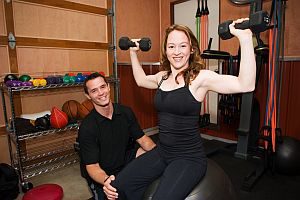Spinal Health at the Gym—Form Matters!

Whether you are an athlete training for competition or someone who visits the gym regularly just to keep fit, protecting your back and spine from injuries during workouts is important. A large-scale University of Arkansas study found that after injuries to the hand, injuries to areas ranging from the neck to the lower back were the most common type of gym-related injuries.
Back injuries at the gym are more common today due to the large amounts of time we spend sitting at a desk or hunched over a computer. According to personal trainer Justin Price, a specialist in functional fitness and corrective exercise, “If someone is rounded throughout the day in their upper back, and then they go to the gym and do an overhead shoulder lift standing, their upper back cannot extend properly. They straighten and arch upward from their lower back, which has a nervous breakdown because it’s getting all the stress.”
Price suggests that in order to avoid injury you consider getting a personal trainer who can show you the proper way of performing exercises and using equipment. The most important way to maintain good spinal health is to strengthen your core muscles. These are the muscles that lend strength and support to the spine, and which tend to become weakened with long periods of sitting. Following are a few tips on how to use proper form when exercising or lifting weights in the gym.
Tighten your gluteus muscles – When performing a squat, deadlift, or during pushups, be sure to squeeze your glutes. This ensures that the muscles connecting your lumbar and sacral areas are locked so your hips and lower back move as a single unit. Otherwise there is a tendency for the lower back to curve, with the vertebral discs being exposed to more stress than they are designed to handle.
Tighten your abs – So as to keep your spine from arching too much in either direction, tighten your abdominal muscles like you are preparing to be punched in the stomach. This will provide stability to the spine as you bend and lift.
Pull your shoulders down and back – A rounded upper back is one of the leading causes of back injury. It increases pressure on the front side of the vertebral disks, increasing the risk of disc herniation.
Keep hips and shoulders aligned – Back injuries happen more often when twisting and bending. Ensure that your hips and shoulders move as one unit. If you need to change direction, lead with the hips and the shoulders will follow. If you lead first with the shoulders, the hips tend to fall behind, too late to keep from overstraining the low back muscles.






 Why “low impact” cardio exercises? Imagine reaching your “golden years” with a buff beach body only to be told that you can’t jog or run anymore because your knee cartilage has been worn thin or you have damaged vertebrae. The last thing you want to do is ruin your body while trying to stay in shape. Here we present some good low impact cardio exercises that can help you maintain a healthy cardiovascular system without causing damage to your musculoskeletal system.
Why “low impact” cardio exercises? Imagine reaching your “golden years” with a buff beach body only to be told that you can’t jog or run anymore because your knee cartilage has been worn thin or you have damaged vertebrae. The last thing you want to do is ruin your body while trying to stay in shape. Here we present some good low impact cardio exercises that can help you maintain a healthy cardiovascular system without causing damage to your musculoskeletal system.
 Forming new habits can be just as difficult as breaking old ones. But when you stop to think about it for a moment, it is clear that all of our habits, both positive and negative, had a beginning—a time BEFORE the behavior became a clear, recognizable pattern. In other words, there was a time when your current habits weren’t yet habits at all!
Forming new habits can be just as difficult as breaking old ones. But when you stop to think about it for a moment, it is clear that all of our habits, both positive and negative, had a beginning—a time BEFORE the behavior became a clear, recognizable pattern. In other words, there was a time when your current habits weren’t yet habits at all!